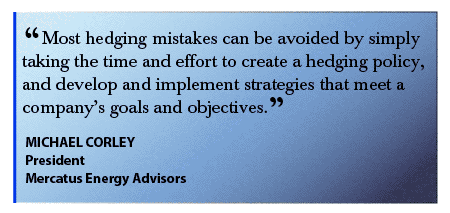
Hedging
Long-Term Trends Define Hedging Strategies
By Gregory DL Morris, Special Correspondent
HOUSTON–Hedging strategies among independent oil and gas producers are as diverse as the companies implementing the strategies. Some operators hedge virtually all of their oil and gas production, some selectively hedge a certain percentage of production, and still others may hedge only one commodity or the other. Some companies lock in prices for five or more years into the future, while others may hedge only 12 months out. There are highly sophisticated hedging programs that use a variety of financial instruments, and others that use a fairly straightforward collar or put option.
Whatever the particular strategy, sound hedging practices protect against commodity price risks while generating value-creating benefits that can enhance an organization’s financial health and wellbeing. For that reason, hedging has become a matter of routine business procedures for many independent companies to cope with shifting supply and demand dynamics, financial uncertainties and commodity price volatility.
Banks and private-equity lenders often require borrowers to hedge, especially in relation to asset acquisitions, and there are producers that are reluctant to hedge unless their capital backers compel them to do so. However, Michael Corley, president of Mercatus Energy Advisors, points out that the natural gas price spikes this winter underscore the importance of having a comprehensive strategy for both sales and risk management.
“If you look at the April New York Mercantile Exchange contract, which is the nearest term, it went from $3.50 per million Btu in November 2013 to about $5.20/MMBtu in January, and then settled back to around $4.60/MMBtu by the beginning of March,” says Corley. “The essential point is that at the start of March, natural gas was trading more than $1 higher than it had been only a few months before.”
That run-up in winter prices meaningfully impacted the 12-month strip, with natural gas futures prices above $4.00/MMBtu through spring 2015 as of the end of February. However, the impact was minimal on 24-, 36- and 48-month strip prices. In fact, longer-term futures prices appear to be a model of stability. On March 5, Henry Hub physical futures from April 2014 through January 2024 were trading within a $1 band between $4 and $5 an MMBtu over the entirety of that almost 10-year period (Henry Hub is the reference price for NYMEX).
Long-Term Focus
So what are independent producers to make of the short-term price jumps experienced in the winter of 2013-14 contrasted with the long-term flatness of the futures price curve through 2024? How should they position themselves to maximize the value of their natural gas production going forward?
“By early March, many producers had missed out on the price spike that took spot prices higher than $6/MMBtu, and saw the New York City gate price briefly soar to more than $100/MMBtu,” Corley states. “But then only very few producers have been able to position themselves to take advantage of short-term price moves like that. Indeed, more often than not, we do not advise companies to try to play in the very short term.”
Tactically, Corley explains that oil and gas producers are wise to ask first what is happening with spot prices, and then what is happening with longer-term contract prices. That is not so much in the sense of what each upward or downward price tick might mean, but in how they translate into broader day-to-day, week-to-week, month-to-month and even year-to-year trends throughout multiple heating and cooling seasons/storage injection and withdrawal cycles.
“The average producer cannot easily take advantage of temporary price gyrations such as what the market saw earlier this year as a result of the severe winter weather across so much of the country,” Corley continues. “If a producer is looking to hedge anyway, then certainly there are advantages and opportunities to lock in higher prices. The market has seen Henry Hub prices go from $3.50 to $5.20 and then back to $4.50, which is still a number producers had not seen in more than a year. We have seen a net appreciation of at least $0.50/MMBtu from a long-term perspective.”
Philosophically, independent oil and gas producers are optimistic by nature, expecting gas prices to rise, Corley recapitulates. “It is in the nature of being an individual producer. Some producers do not hedge because they do not want to miss any opportunity for price appreciation.”
That predilection toward steadily rising prices runs into the market realities of supply and demand. “Consumers understand that as much as do producers,” says Corley. “Buyers, and especially big buyers, expect that when supplies start to get tight, and prices start to rise, an increase of about $1 an MMBtu should to be enough for producers to bring marginal wells into production. Of course, that $1/MMBtu change can vary greatly in its relative importance depending on where prices started.”
Consequently, he says independents should strongly consider put options, which simply gives the producer the right to sell at a specific price within a specific period, regardless of the current market price. “The put option acts somewhat like an insurance policy,” Corley relates. “Even in a declining price environment, the put option allows a producer to retain the benefit from a possible price appreciation.”
If prices rise, the put simply expires unused. “Of course, like any insurance, you pay a premium for the loss protection,” Corley adds.
There are also hedging techniques that do not have any net expense. A common one is called a “costless” collar. As the name suggests, it is a collar, with limits on how much higher or lower the price moves. In practice, it is the combination of a producer buying a put option and selling a call option, with the premium prices offsetting one another so that it is costless.
“Costless collars have their time and place, but often we see them misused and users with regrets,” he relates. “We believe the technique often means surrendering too much upside as compared to the downside protection. With a costless collar, you are protected from pain, but you often do not get much gain.”
Common Misconceptions
According to Corley, there are several common misconceptions about hedging. One of the biggest is looking at hedging as a way to make money. “Hedging should be regarded as a risk management tool. It is a way to enhance corporate financial performance, but it should not be considered a potential source of revenue,” he remarks. “At the very least, hedging should provide protection against potentially declining prices, but a sound oil and gas program should provide certainty for cash flow and revenue/profit.”
An ill-conceived hedging position can be a net value reducer to the bottom line, Corley goes on, with the vast majority of hedging mistakes resulting from a poor or nonexistent hedging policy, and/or the lack of a well-designed strategy. “Most hedging mistakes can be avoided by simply taking the time and effort to create a hedging policy, and develop and implement strategies that meet a company’s goals and objectives,” he says.
Another misconception is that engaging in hedging programs is tantamount to trying to “outsmart the market.” “No one can know where prices will go in the future, so hedging decisions should never be made based on one’s view of future prices. If it was easy to predict prices in the future, many of us would have retired early and be spending our days on the beach and golf course,” Corley quips, adding that attempting to base a hedging program on market “timing” or speculation about future prices may expose a company to more risk than not hedging at all.
“We sometimes hear from companies that say they only hedge when they have a strong view of the market or when they see ‘good opportunities.’ The obvious question is what happens if that view turns out to be wrong? What if a ‘good opportunity’ does not present itself?” he asks. “What if prices begin to decline? Are you going to have the discipline to hedge at that point, or will you continue to wait and see if prices will bounce back? The time many never seem quite right to hedge, but waiting until the time does seem right can be as costly as hedging based on guessing future commodity prices.”
An oil and gas hedging program should be grounded in a purposeful, concise long-term strategy that considers all market conditions and price environments, Corley reasons. “Commodity prices change, so managers will want to look at how high, moderate and low commodity price scenarios could impact their operations and then hedge accordingly,” he advises. “Most importantly, once a strategy is in place, the producer must stick with it. Hedging success is measured over the long term.”
Major Variable
The rise in natural gas prices this winter is indeed significant, but it reflects a short-term weather phenomenon rather than a long-term pattern, Corley holds. “We are not just talking about a cold winter in the Midwest and Northeast, but all across the country,” he reminds. “I cannot remember the last time I had to wear a wool sweater and heavy coat in March in Houston.”
The abnormal cold resulted in a massive storage drawdown that pulled 2.64 trillion cubic feet from inventories between early November and the end of February, leaving lower-48 storage volumes at their lowest levels in a decade, according to the U.S. Energy Information Administration. For historic perspective, the five previous winters averaged 1.83 Tcf in drawdown from early November through the end of February.
With March weather still to come, EIA reported that the 1.2 Tcf in storage during the final week of February was 908 billion cubic feet (43.2 percent) less than the 2.1 Tcf in storage one year earlier and 758 Bcf (38.8 percent) below the five-year average of 1.95 Tcf. But even as the long winter finally passes into spring, weather will remain the major variable as storage injection season gets underway, according to Corley.
“If the cold and wet weather lingers and we get into May without significant storage refill, prices could remain firm right through summer and into the start of next winter’s heating season,” he comments.
At that point, “gas prices across the board will likely start to face serious pressure because production would be expanding so much,” Corley anticipates. “There is simply so much production from the Marcellus Shale, and now the Utica Shale as well, that supply is almost certain to overcome demand should prices be sustained at high enough levels.”
How much storage is replenished and how quickly remain to be seen, of course. He suggests, however, that the more important indicator of long-term prices will not be the volume of gas left in storage at the end of this winter, but the amount in inventory at the start of next winter.
And even if the upcoming summer is hotter than normal, Corley says the odds are there will be plenty of supply available to build storage inventories in advance of the winter 2014-15 heating season. “Natural gas has taken a large chunk of the power generation market from coal for both economic and environmental reasons, creating significant summer cooling demand in addition to traditional winter demand. Weather still matters, as the past winter has demonstrated. But there is just so much production capacity available today that we do not think that even a hot summer will significantly hamper injection rates,” he reasons.
For other great articles about exploration, drilling, completions and production, subscribe to The American Oil & Gas Reporter and bookmark www.aogr.com.







